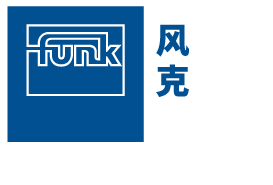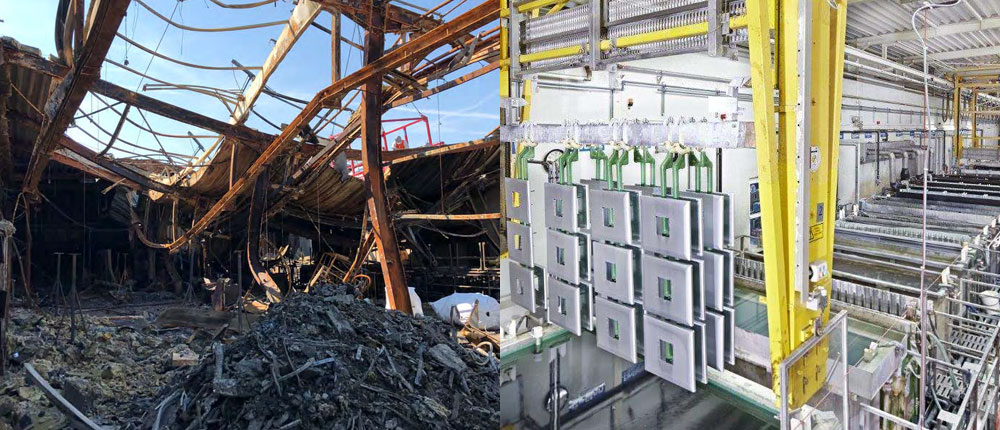Reporting on a major fire: from the first alarm to the final claim adjustment
When Lars Imbeck’s phone rings, it usually means big money is at stake. The claims coordinator at Funk handles all types of claims involving major material damage. He comments on his most memorable case for Funk’s corporate blog: the major fire at the premises of construction supplier Schüco in 2019.
Sunday, 17 March: smoke, flames and toxic extinguishing water
At 6:36 p.m., a fire alarm goes off in plant 2 of Schüco’s Borgholzhausen premises in North Rhine-Westphalia. A fire has broken out near the anodisation system. Handles, aluminium parts and fixtures for kitchens, for example, are produced here. The fire brigade arrives at 6:50 p.m. By 7:30 p.m. the smoke is thick and the flames are coming through. The fire is finally under control at 10:30 p.m.
Lars Imbeck
The anodisation system is a galvanic system with more than 30 tanks containing salts, copper and cadmium, among other substances. Parts such as aluminium kitchen handles undergo chemical/electrical processes in these tanks – common practice in the industry.
The air pollution is measured at the same time and the German warning app NINA is triggered. By 11 p.m. air pollution levels have dropped to normal.
Lars Imbeck
Fires always produce air pollution. What helped in this case was that the extinguishing water from the fire brigade was collected in the retention basin in the basement and disposed of. Drainage to the combined sewer was blocked off early, which prevented environmental contamination. The extinguishing water is special waste that must be disposed of accordingly.
Investigators are not yet able to say what caused the fire directly after the flames are extinguished. The hall is at risk of collapsing and the site is blocked off. Everything from arson to an electrical fault will be investigated.
Lars Imbeck
The investigators are not the only ones who want to find out what happened. When companies know the cause of the damage, they are able to improve their fire protection measures. This is why they often send in their own assessors, which is what happened here as well.
Monday, 18 March: an effective claims team
Schüco informs its insurance broker, Funk, about the damage on Monday morning. It quickly becomes clear that this will be a major claim. Funk puts together its own task force and informs the leading insurer, HDI. Together they build a claims team comprising building, operating equipment, stock and business interruption experts, as well as chemists, structural engineers, damage assessors and a restoration company.
Lars Imbeck
We have a large network of experts upon whom we can call. Add to that experts from the insurer’s side and sometimes from the client. In this case there was an advisory board, so everyone involved pulled together and worked as a team. It is not unusual for so many different people to be on site after a fire. Some clients find it confusing, on top of what is already an extraordinary situation for them. That’s why we think it is always important for Funk to be there as the main point of contact, managing the flow of communication.
Tuesday, 19 March: initial clean-up and drone surveillance
The team is on site, discussing tasks, processes and action plans. Initial conservative estimates put the material damage and business interruption losses at up to 30 million euros. Two halls are at risk of collapsing and have to be dismantled, a costly and labour-intensive job. Drones are used to uncover the extent of the damage in the halls. The structural stability of a third hall is being investigated.
Lars Imbeck
It would have been dangerous to enter the halls, even if they weren’t blocked off by the police. We commissioned the drone company through the insurer. This company produced a 3D scan that provided important findings.
Initial planning, development and assembly lead times quoted for reinstating the anodisation system indicate that operations will be down for at least 15 months.
Lars Imbeck
What’s important is that the restoration company arrives on site quickly and can start the clean-up, so that the business interruption is as short as possible. What’s more, external capacities both in the country and abroad should be determined immediately in such cases, so that the company can continue to deliver to its customers.
The leading insurer releases a first partial payment amounting to millions directly on 19 March.
Lars Imbeck
The extent of the damage is not yet clear immediately after a fire. The insurer’s initial payout should give the company some liquidity, but it’s not an indication of where the overall claim adjustment will land just yet.
The following weeks and months: contract manufacturers and new building plans
Two additional insurers from the insurance pool register their involvement in the claim adjustment process within the first week. On 8 April Schüco reports that the first batch of products is back from the contract manufacturers and the quality is still being tested at this point.
Lars Imbeck
It is common for there to be what’s known as a claim adjustment committee when a major claim arises. Funk manages everything here as well and communicates with the client.
Investigators have still not released two of the halls. Schüco is organised extremely well and able to provide construction documentation, fire protection concepts and Emission Control Act permits. Nevertheless, the cause of the damage cannot be conclusively determined. Debris is cleared and disposed of on 8 July, and there are new building plans in place.
Lars Imbeck
We were able to speed up the process by providing investigators with assistance from our own expert assessor. It is important for access to the site to open up again in order to push forward with dismantling and demolition work.
Settling the bill at the end of the year: how much did the fire cost?
The damage to the building amounts to a medium seven-digit figure, not to mention the disposal and restoration costs. It will take 15 months to rebuild.
Lars Imbeck
The damage was enormous. I can still remember what it looked like. Several adjacent hall sections were destroyed and there was debris everywhere.
The damage to the operating equipment is estimated to be a high seven-digit figure for one-to-one reinstatement, which will take 17 months.
Lars Imbeck
Technological progress and filling the galvanic tanks for the first time were included in this calculation, among other things.
Damage to stock is also taken into account, but the estimated costs are significantly lower than other considerations.
Lars Imbeck
Stock in this case included raw materials like oil and grease, semi-finished goods and finished goods.
The business interruption is calculated to cost several million euros. Provisional measures managed to reduce this figure. It was also possible to renegotiate the prices for contract manufacturing, which also mitigated the business interruption costs.
Lars Imbeck
This is a case in point of how quick action literally pays. The earlier steps are taken, the less damage there is. That’s why we set all of the levers in motion to get the right claims team on site quickly.
Schüco tests different rebuilding options, including at other locations. On 9 December the company decides to settle the cost of the material damage to the buildings, operating equipment and stock based on the estimated values. The material damage is settled mutually between the parties.
Lars Imbeck
It is a strategic decision of the company as to whether buildings and machinery destroyed by fire are rebuilt or not, or whether other locations should be used or whether some of the manufacturing is outsourced. Settling early based on estimated values gives the company some flexibility.
The business interruption damage remains open until technical commercial operations are finally re-established and is settled in 2021.
Lars Imbeck
Major claims are complex and take time. That’s why it is especially important to us that we can be reached at any time.




